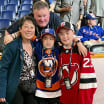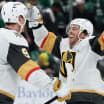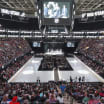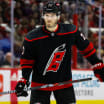Hughes, USA Hockey poised to make history in 2019 NHL Draft
NHL.com takes inside look at National Team Development Program's success
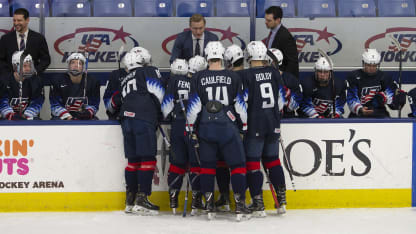
© Rena Laverty
Such player meetings and instruction were the norm this season for the coach of USA Hockey's National Team Development Program (NTDP) Under-18 team, as were practice plan briefings, team meetings, practice sessions and off-the-ice monitoring.
Wroblewski needed to keep such a busy schedule to live up to the high standards set at the two-year residency program for the top 16- and 17-year-old players in the United States. The NTDP, which also includes the Under-17 national team, has helped foster a breeding ground for the country's aspiring hockey players since its inception for the 1997-98 season.
RELATED: [Complete NHL Draft coverage]
Hughes, a center widely projected as the No. 1 pick, and Caufield, a right wing, are two of 19 players on the U-18 roster listed in NHL Central Scouting's final ranking of North American skaters and goalies eligible for the 2019 NHL Draft. They entered the coach's office and took their seats, and Wroblewski began advancing and pausing highlights of Chicago Blackhawks forwards Patrick Kane and Alex DeBrincat, New York Islanders center Mathew Barzal and Calgary Flames left wing Johnny Gaudreau. He manipulated the action from a keyboard on his lap that was connected to a 45-inch, flat-screen television 10 feet away on the wall opposite his desk.
"Cole, look at DeBrincat and how he finishes his route on the forecheck," he said. "Jack, watch how Gaudreau keeps wheeling but then does a good job pulling up and hanging around back post for an easy slam dunk. It's those little pockets we can't neglect."
The session lasted 10 minutes.
"He's expanding our minds a little bit and wants to help us find areas to score and create a little bit more," Hughes said.
Wroblewski put it another way: "I'm just looking for another level to [add to] their already exceptional status."
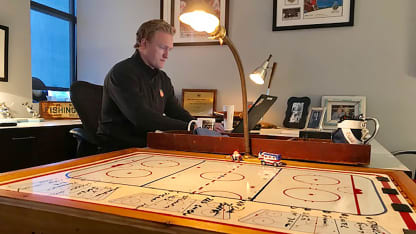
© Courtesy: USNTDP
The coach did that a lot this season. The current U-18 group might be the deepest, most talented collection of teenagers in the 22-year history of the program.
A record 17 players from the program attended the 2019 NHL Scouting Combine in Buffalo this month. Among them are six skaters projected by NHL Central Scouting to be selected in the first round of the 2019 NHL Draft at Rogers Arena in Vancouver on Friday (8 p.m. ET; NBCSN, SN, TVAS) and Spencer Knight, who is No. 1 on Central Scouting's final ranking of North American goalies.
Never have more than three players been chosen directly from the NTDP in the first round, but that figures to change, as does another trend: Never have more than four United States-born players been picked in the top 10, but there could be as many as five NTDP players selected in that range this year, according to Central Scouting's projections.
Hughes is expected to be the fifth NTDP player chosen No. 1 in an NHL Draft. He's one of many who have graduated from the program with high expectations, but the 18-year-old could be the first NTDP player to go directly from the draft to playing in the NHL.
NHL.com visited the NTDP in Plymouth, Michigan, in March for an inside look at the program that produced this group of players who are poised to make history.
Individual, team accomplishments
It remains to be seen whether the 2001 birth-year group, which first convened in March 2017 at NTDP selection camp in Plymouth, will be considered the most successful.
The NTDP plays teams from the United States Hockey League (players from ages 16-20) and opponents from NCAA Division I and III in addition to competing in three international tournaments each season.
Highlights of USA Hockey NTDP forward Jack Hughes
This season's U-18 team, players who made up the U-17 team in 2017-18, won four of six international events dating to October 2017 and went 29-2-1 against international competition, including an 18-game winning streak. It went 14-0 against international competition in 2017-18 and 15-2-1 this season, which ended with a third-place finish at the 2019 IIHF World Under-18 Championship.
"People seem to forget that when you're playing at the NTDP, it's the hardest schedule in minor hockey," said Jim Hughes, Jack's father. "You're playing against Division I colleges, a difficult USHL schedule against kids three to four years older and then a challenging international schedule leading up to the World Under-18 Championship.
"It's a monster travel schedule, and I give those kids a lot of credit. They've done a wonderful job in Plymouth, and all those players have been tested up to this point in their lives. I think they're all on the right track for a new challenge."
That next challenge will either be college or, in some cases, the NHL, which shouldn't be too surprising. The program has helped prepare many of the best United States-born players in the League, such as Kane, Detroit Red Wings center Dylan Larkin and Columbus Blue Jackets defensemen Seth Jones and Zach Werenski. There were 85 NTDP alumni who played in the NHL this season.
There are 17 NTDP players listed in NHL Central Scouting's final ranking of North American skaters -- Sioux Falls, which had six out of the 217, was second -- and two players among the top four in its final ranking of North American goalies.
The third-place finish in the World Under-18 Championship this year marked the 16th straight time the United States has ended up in the top three, by far the longest streak of any country. (Russia did it five straight times from 2000-04, winning twice, finishing second twice and taking third once.) The U.S. run includes nine championships, four second-place finishes and three third-place finishes. The event began in 1999.
The current group has also had plenty of individual success during its two-year NTDP stint, headed by the seven players Central Scouting projects as first-round picks:
• Hughes (5-foot-10, 171 pounds), No. 1 in NHL Central Scouting's final ranking of North American skaters, had 20 points (nine goals, 11 assists) as captain to lead the 2019 World Under-18 Championship in scoring and set the record for most points at the event with a combined 32 (14 goals, 18 assists) in 14 games in 2018 and 2019. Washington Capitals forward Alex Ovechkin held the previous record of 31 points (23 goals, eight assists) in 14 games for Russia in 2002 and 2003. Hughes holds the NTDP career records for assists (154) and points (228), having played 110 games. He's expected play in the NHL next season.
• Caufield (5-7, 163), No. 8 in Central Scouting's final ranking, led the United States with 14 goals at the World U-18 tournament, tying Ovechkin's single-tournament record set in 2002. The right wing had 100 points in 64 games (1.56 per game) with the NTDP this season, set a single-season record with 72 goals and became the all-time leader with 126 goals in 123 games. He passed forward Phil Kessel (104 goals in 117 games, 2003-05), now with the Pittsburgh Penguins, for the NTDP lead. Caufield will attend the University of Wisconsin in 2019-20.
Highlights of USA Hockey NTDP forward Trevor Zegras
• Center Trevor Zegras (6-0, 173), No. 6 in Central Scouting's final ranking, was third on the U-18 team with 87 points (26 goals, 61 assists) in 60 games and is fourth in NTDP history with 100 assists. Zegras will attend Boston University in 2019-20.
• Goalie Spencer Knight (6-3, 193), No. 1 in Central Scouting's final ranking of North American goalies, finished 32-4-1 with a 2.36 GAA, .913 save percentage and two shutouts in 39 games this season, tying Vancouver Canucks prospect Thatcher Demko (2012-13) for most wins at the program in a season. He set the record for career NTDP wins with 59 in 78 games. Knight will attend Boston College in 2019-20.
• Defenseman Cameron York (5-11, 172), No. 12 in Central Scouting's final ranking, led all defensemen at the 2019 World Under-18 Championship with 11 points (four goals, seven assists) in seven games. He set the record for most points (103) by a defenseman in two seasons (122 games) at the program and is 10th in NTDP history with 81 assists. York will attend the University of Michigan in 2019-20.
• Left wing Matthew Boldy (6-2, 196), No. 9 in Central Scouting's final ranking, was fourth at the program with 81 points (33 goals, 48 assists) in 64 games and is fifth in NTDP history with 95 assists. Boldy will attend Boston College in 2019-20.
Highlights of USA Hockey NTDP forward Alex Turcotte
• Center Alex Turcotte (5-11, 186), No. 4 in Central Scouting's final ranking, had 62 points (27 goals, 35 assists) in 37 games, missing 22 games with a lower-body injury, and ranked second on the U-18 team with a 1.68 points per game. He is tied for 11th in NTDP history with 80 assists. He will attend the University of Wisconsin in 2019-20.
There were others who played key roles and are listed in Central Scouting's final ranking of North American skaters and goalies: defensemen Alex Vlasic (No. 38 among skaters), Henry Thrun (No. 39), Drew Helleson (No. 46), Marshall Warren (No. 61), Domenick Fensore (No. 68) and Case McCarthy (No. 77); forwards John Beecher (No. 49), Judd Caulfield (No. 67), Patrick Moynihan (No. 73), Owen Lindmark (No. 93) and Michael Gildon (No. 110); and goalie Cameron Rowe (No. 4).
"It's a group of alpha males, and it actually is amazing that they get along as they do," Wroblewski said. "The jealously factor doesn't set in. It's unbelievable to watch them practice, watch them carry themselves every day. They're trying to be better than they were the day before. They are all unique individuals."
Programmed to succeed
The success of the program isn't surprising to former members who are now NHL veterans.
Penguins defenseman Jack Johnson, who recently completed his 13th NHL season, played with the NTDP from 2003-05. He referred to the program as a two-year boot camp, but in a good way.
"Everyone there has a tremendous amount of God-given ability and talent, but they don't try to mold you into a certain type of player," Johnson said. "They want to make you a better athlete and allow that athlete to take over on the ice."
That's what former USA Hockey vice president Ron DeGregorio envisioned when he began brainstorming the idea of the NTDP in the mid-1990s. It bothered him that the United States had not won a non-Olympic international tournament since 1933.
That ultimately led to discussion of a developmental program that would help on and off the ice to turn ambitious American teenagers into major contributors. Coaches opposing the creation of the program feared it would not only pull potential recruits or current players away from their programs, but that it would cost too much money to maintain.
"We said we needed to do it and improved performance would end up resulting in better results in major tournaments," said Dave Ogrean, who was then executive director of USA Hockey. "It would also enable us to do a better job in attracting corporate sponsorship and help produce more high-performance players who would become key contributors and high NHL Draft picks."
The cost to run the NTDP during its first season (1997-98) was $2.5 million, according to USA Hockey. The cost was just more than $4 million in 2018-19. The NHL provides a grant to USA Hockey each year to help fund the NTDP and other initiatives such as college hockey, officiating development, membership development and the American Development Model, USA Hockey's age-appropriate, age-specific competition and training structure that provides a nationwide blueprint for youth hockey.
"There was a time when coaches complained about the NTDP taking away their best players," said Scott Monaghan, senior director of operations at the NTDP and USA Hockey Arena, and the only person with the program since its inception. "We're at a point now where youth hockey programs are promoting the NTDP, and that's a big difference. We just need to continue to do things the right way and stay ahead of the curve."
Wroblewski has done that. A forward who played in the program for two seasons (1997-99), he was an intern assistant (2007-08) and full-time assistant (2008-10) and has been coach the past two seasons for the 2001 birth-year group. (NTDP coaches keep the same group of players for their U-17 and U-18 seasons before rotating back.)
The 38-year-old said the program's core values, instituted by the NTDP's initial architects -- coach and senior director Jeff Jackson and director of player personnel Bob Mancini -- remain intact. But there is one philosophical difference.
"If you look at the name behind the acronym (NTDP)," Wroblewski said, "I think in the beginning, the emphasis was to develop national teams, whereas I think now we're developing the player more so than the development team."
He recalled how video meetings used to focus on team concepts, keeping the puck out of the net, and forecheck systems.
"Sessions today are pertinent to offensive skills like proper form on one-timers or a predictable read on the line rush so guys like Zegras can make a no-look pass," Wroblewski said. "Video quality and sophisticated editing systems make it much more possible to get creative with your breakdown and really hone in on individual development."
Wroblewski provides 1-on-1 instruction with Zegras
Wroblewski wants his players to thrive with regard to speed and creativity. It might seem simple, but there is elaborate methodology and experimentation in executing a practice the right way.
"My ideals are fostered in game-like drills that use minimal numbers and almost always have an odd amount on each team," he said. "The team with more players gets to work on easier offense, which means back-door plays and crossing patterns. The team with less players focuses on hard skill and taking straight lines. All the drills test the computers on our players. I'm a firm believer that if you challenge someone to practice smart, they'll rise up.
"If you don't believe in a player's ability to build his IQ, you'll have a limited player with little growth."
'A long day for a kid that age'
USA Hockey assembles the Under-17 team after an evaluation camp held each March with 40 to 50 players invited. Headed by director of player personnel Kevin Reiter and assistant director of player personnel Rod Braceful, the organization's talent evaluators around the country select those invitees from the pool of players with a particular birth year who are registered with the organization nationwide; the 2019-20 U-17 team came from a pool of 20,348 registered male players born in 2003.
Players realize committing to the program means much more than working hard on the ice. There also is schooling and a strict weight-training program.
Prior to moving to USA Hockey Arena in Plymouth on April 1, 2015, the NTDP was based 20 miles away in Ann Arbor for 19 seasons, with players attending either Pioneer High School or Huron High School. Today, NTDP members attend one of three high schools: Plymouth, Northville or Novi.
Each player attends the school in the community where he lives with his billet family, and the goal is to spread the players on the U-17 and U-18 teams evenly among the three districts.
For 15 seasons, director of student-athlete services Lisa Vollmers has been responsible for enrollment and registration of NTDP players, monitoring of academic achievement and attendance, and housing for players with billet families. Academic expectations are much higher than the program's required 2.3 grade-point average.
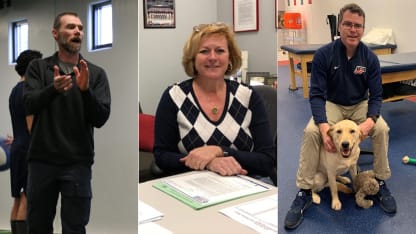
The group to surpass from an academic standpoint is the 2011-13 NTDP team (1995 birth year), which finished with a two-year GPA of 3.61.
"It's tough when you're trying to manage time with school and homework and tests and that sort of thing," said Jones, who played with the NTDP from 2010-12. "At the rink there was a lot of emphasis on the game of hockey, getting bigger and stronger in the weight room. I went in there 6-foot-1, 180 pounds, and left 6-foot-3, 205 pounds in two years."
"The program also helped you learn how to overcome a lot of stress."
Vollmers said curfew is 9 p.m. on a school night and 10 p.m. on weekends, unless it's a game night, in which case it's 11:30 p.m. Intern coaches perform location checks of each player by conducting random curfew calls during the season.
A typical schedule for a player in the NTDP on a nongame day could look like this:
7:30-11:45 a.m.: Attend public school at Plymouth High, Northville High or Novi High
11:50 a.m.-12:15 p.m.: Individual player meeting with coach
12:15-12:40 p.m.: Lunch at USA Hockey Arena
12:45-12:55 p.m.: Team meetings
1 p.m.: Team lift (weight room)
2-4 p.m.: Practice
4:15-5 p.m.: Mandatory study hall with education director
5-6 p.m.: NHL scouting meetings/interviews
"I was probably 15 when I went in," said Kane, who played with the NTDP from 2004-06, "and you're going to school, showing up at the rink, practicing for two hours and then you're going into the gym for an hour and a half, getting back from your day at 6:30 at night. It's a long day for a kid that age, but after a while you really start building your body."
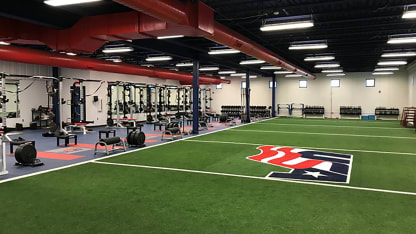
© Courtesy: USNTDP
The weight training for NTDP players takes place at a 9,800-square-foot, state-of-the-art workout facility at USA Hockey Arena. Strength and conditioning coach Darryl Nelson used it as his classroom for 19 seasons before retiring at the end of this season.
"Strength and conditioning programs are really two parts: reducing injuries and improving speed," Nelson said. "Our warmup stuff involves foam rollers, stretching, and stuff geared towards trying to reduce injuries while getting them out of that seated posture they're in all day at school to get them prepared to work."
Nelson said a good workout on off days can be completed in 40 minutes. But Knight said he has never been in a hurry to do so.
"I don't go to the gym to just throw a bunch of weights around and think I'm 10 times stronger," said Knight, who finished in the top 15 in eight of the 13 testing categories at the scouting combine. "I'm not trying to get it done in 30 minutes so I can get on the ice right away. You have to do everything with a purpose, don't cheat yourself and get what you want out of it."
Zegras and Caufield practice in the shooting room
Some players might decide to work on their shooting and passing in the 1,800-square-foot shooting room installed three years ago. It is surrounded by netting and includes a regulation-size net.
Players can also look to the program's head athletic trainer, Jason Hodges, for assistance throughout the season. Hodges, who just concluded his 21st season with the program, has an office next to the locker rooms.
"The trainer's room sometimes tends to be a hangout as well," Hodges said. "We've got recovery boots and a cold tub. The Ann Arbor facility was a quarter of the size, so this was definitely an upgrade."
That aspect of the facility is certainly appreciated by the players, particularly after a tough practice session.
Pushing the right buttons
Wroblewski runs six-to-10 practice drills on nongame days. During one drill, "Speercat Sully," he stands along the boards and blows his whistle to alert players in either corner to skate, maneuver and crash the net with a purpose.
The drill, which consists of nonstop skating and contact for eight minutes, requires two players from one team to back check against two others between nets 64 feet apart. When NHL.com visited, tempers flared midway through the drill when Zegras was cross-checked by McCarthy. Zegras returned the favor, and a twisting bear hug ensued as teammates converged to separate the two. The episode ended, and practice resumed.
John Wroblewski goes over strategy with his team
"Rarely is there true animosity between players, but it's just what happens when emotions boil over," Wroblewski said. "There is so much mutual respect in that room that no one is going out of their way to do something to another player on the team."
The practices provide a good example of just how competitive and relentless players are in attempt to gain an edge.
"No one trains harder than we do at the NTDP," Hughes said. "You're fighting for spots on the roster every day. You're trying to move up the depth chart, get certain positions on the penalty kill or power play. We're good friends off the ice, but on the ice ... Let's just say it's really competitive."
Wroblewski said Hughes is the hardest-working player he's ever seen. The coach remembers well the first time he had to make a point early on in his relationship with the young forward, whose brother, Quinn Hughes, was with the NTDP at the time.
"I got to meet this kid at 15," Wroblewski said. "… At the time, I had already established a relationship with parents Jim and Ellen Hughes, and his brother, Quinn, was thriving. I'm sure when he was home, he's calling me Wrobo around the family. The parents call me Wrobo all the time.
"After Jack decided to play for the NTDP, I remember him walking up to me and saying, 'Hey Wrobo, how ya doin'?' I went right over to him and said, 'Hey Jack, I'm your coach ... I'm not your buddy.' I turned and walked away, and he hasn't called me Wrobo since."
The player-coach relationship between the two is as respectful as it gets, and one reason why Hughes opted to remain with the NTDP for two seasons.
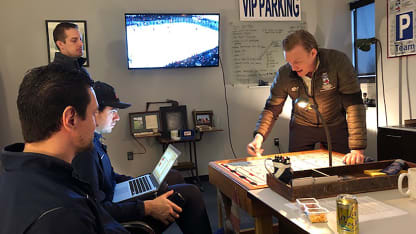
© Courtesy: USNTDP
Wroblewski averaged one 1-on-1 player meeting per practice day and often sat down with assistants Dan Hinote and Kevin Lind to review practice and game plans. Lind ran power-play meetings with the players and Hinote met with the penalty-killing units. Wroblewski usually scheduled a team meeting with all players in the early afternoon in a theater-like room following study hall.
The 55-seat room has a huge screen that Wroblewski and his coaching staff use to better instruct the team either after a practice or prior to a game. When NHL.com sat in on the team meetings there, Wroblewski was breaking down video of the Boston Bruins with the hope of instilling proper work habits.
"Getting to the net front is the constant theme for today, guys ... but it's through different avenues and with versatility," he said. "The Bruins wouldn't be one of the best teams in the NHL without that versatility. Look at the determination from the dot-drive player. [Patrice] Bergeron to the net front ... a simple shot down to the cage, a little push-off right here (against Los Angeles Kings defenseman Drew Doughty) to make him a little uncomfortable, and then its slammed into the back of the net."
Wroblewski's players said he doesn't leave details to chance and pushes the right buttons to get the most out of them. It was a formula for success this season and could be for future NTDP coaches.
"Coach Wrobo really was the best," Zegras said. "For two years it was almost like he took me under his wing. I had so many video sessions with him and he's such a great hockey mind. He always took time out of his day to help out, and his energy in practice was just very motivating."
Wroblewski on the importance of maintaining intensity
A promising future
The program has produced 72 first-round NHL draft choices, including four No. 1 picks: Rick DiPietro (New York Islanders, 2000), Erik Johnson (St. Louis Blues, 2006), Kane (Chicago Blackhawks, 2007), and Auston Matthews (Toronto Maple Leafs, 2016).
"What the program has done, and you've seen the success these (national) teams have had … from where we were to where they are now, is a testament to how good that program is," said DiPietro (1997-98), who was considered Jackson's first big recruit at the program.
The United States finished third twice at the IIHF World Junior Championship in the 20 tournaments before the NTDP began play. It has won the event three times, finished second once, and taken third three times in the past 10 tournaments, including a top-three finish each of the past four years.
Since 1998-99, 310 of 573 players (54.1 percent) representing the program have been picked in the NHL Draft. A record nine players with ties to the NTDP were selected in the first round of the 2016 NHL Draft, including Matthews at No. 1.
Will the program ever see as much NHL Draft-eligible talent on one team as it has this season?
"This year's U-18 team is a generational team," said former NHL general manager Craig Button, who is director of scouting and an NHL analyst for TSN. "I've never seen anything like the depth of the skill ... there could be five kids drafted in the top 10, and it's unprecedented. I've never seen a team that good in the quality of player."
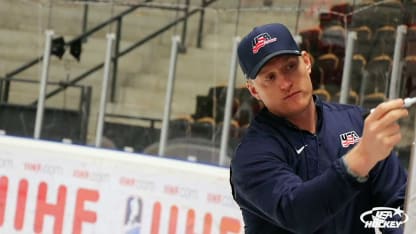
© Courtesy: USNTDP
Though he agrees with Button, Wroblewski didn't rule out the idea of it happening again because the program is continually evolving.
"It's an anomaly until we do it again," Wroblewski said. "We need to keep pushing and getting better, and I feel we're as hungry as ever at the NTDP. We added a new sports science department this year, and I'm breaking down every scoring chance and goal this season, uncovering ad-libbed routes on exits, entries and attacks, and using some of those to create new drills. It's an exercise I haven't done before."
The 2002 birth-year group might not have as many first-round candidates, but 2019-20 U-18 coach Seth Appert said he wouldn't be surprised if as many as six defensemen are selected in the opening three rounds of the 2020 NHL Draft.
"We'll have more picks between Nos. 10-30, whereas this year you're going to see more taken between Nos. 1-15," Appert said. "It goes in cycles."
Then there's the 2003 birth-year group, which will by coached by Wroblewski beginning next season. Next season's U-17 team will include 2021 NHL Draft-eligible defenseman Luke Hughes. The brother of Jack and Vancouver Canucks defenseman Quinn is the last of the hockey-playing siblings.
"Luke looked exactly like I thought he would (at tryout camp in March)," Wroblewski said. "There were times where he tried to do too much and looked awkward, but there was a lot of brilliance too. We'll mitigate the former and bolster the latter."
After all, that's what NTDP coaches are expected to do.
"It's a challenging two years for players at the NTDP," said Pat Kelleher, executive director of USA Hockey. "But that's by design. Our goal is to develop players to be successful at the college, international and professional levels.
"This year's class will be one of our best ever, and they started in youth hockey about the time we introduced the American Development Model. The NTDP and ADM have had an extremely positive impact on hockey in our country and we look forward to continuing to develop world-class players through these programs."
---
Listen: New episode of NHL Draft Class presented by adidas





